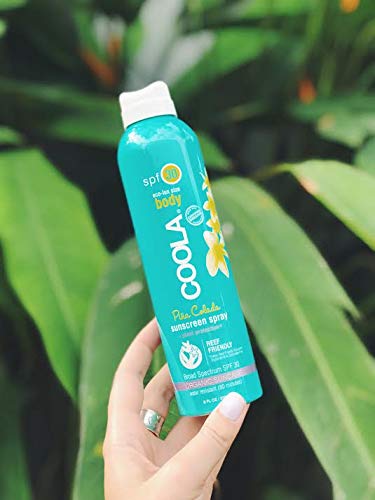

Sure, it all seems a bit tedious but diligence is the best way to protect yourself from future problems, and sprays make the process - especially getting the hard-to-reach parts of your back - at least a little bit easier. in water, sweating or in a situation where the sunscreen might've otherwise rubbed off. How often should you reapply?Īs with all other types of sunscreens, sprays should be reapplied every two hours if you're idle or every hour if you're active - i.e. Instead, you should spray a concentrated amount into your hands and use them to apply it evenly across the cheek bones, forehead and nose, behind the ears and into the scalp, too. Inhaling or ingesting them, the AADA says, is unsafe. You also should avoid, unless the brand specifically says so, applying a sunscreen spray directly to the face or across your lips.
#COOLA SUNSCREEN SPRAY INGREDIENTS FREE#
Sprayable sunscreens can be redirected by wind, so be sure to apply it in a place free from a breeze - like a bathroom. After your skin's reached the point of glistening, you should still rub the solution in, spreading it where droplets might not have reached. Using an up-close, back and forth motion, go over areas four times.
#COOLA SUNSCREEN SPRAY INGREDIENTS SKIN#
"Since it can be difficult to determine how much spray sunscreen is enough, a good rule of thumb is to spray until your skin glistens." Remember to rub it in.īut it isn't enough to just coat the skin. Estimating this amount is harder with a spray but doable still. "Most adults need at least one ounce of sunscreen - about enough to fill a shot glass - to fully cover the body," The American Academy of Dermatology Association says. Sunscreen sprays aren't your way out of lathering up though.


Yes, there are definite rules to follow when using them in order to be properly protected from UVB and UVA rays - see below for a breakdown on both - but they prove best for those prepping for the sun solo, reapplying on the sand or for once you're already sweaty. Sprays service those seeking allover protection. Sticks work well to touch-up larger patches of skin and on odd spots - behind ears and on the back of hands. Lotions, especially ones packed with moisturizing properties, can be rubbed onto the face and neck. Each offers varying advantages during application. There are three types of sunscreen: lotions, sticks and sprays.


 0 kommentar(er)
0 kommentar(er)
